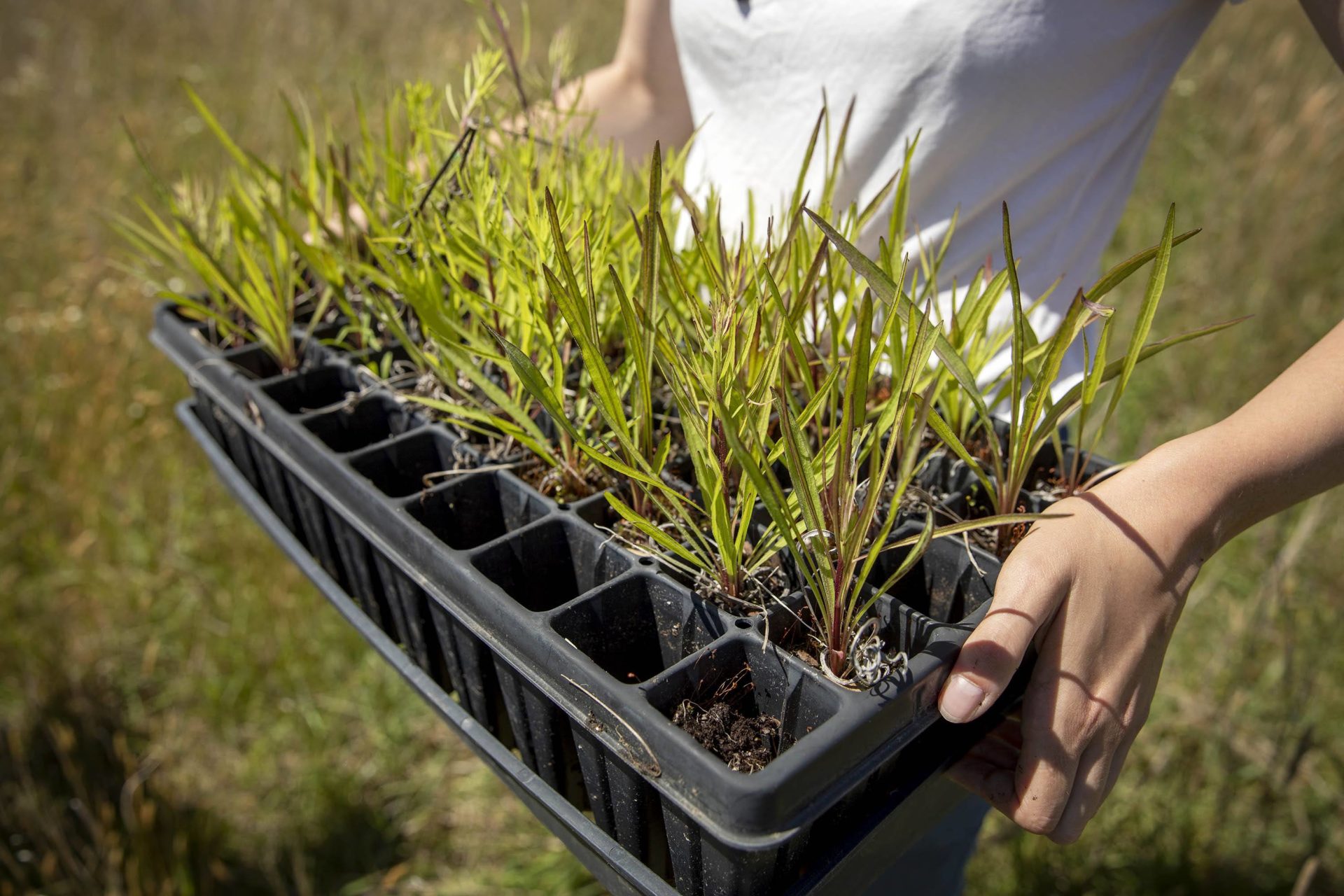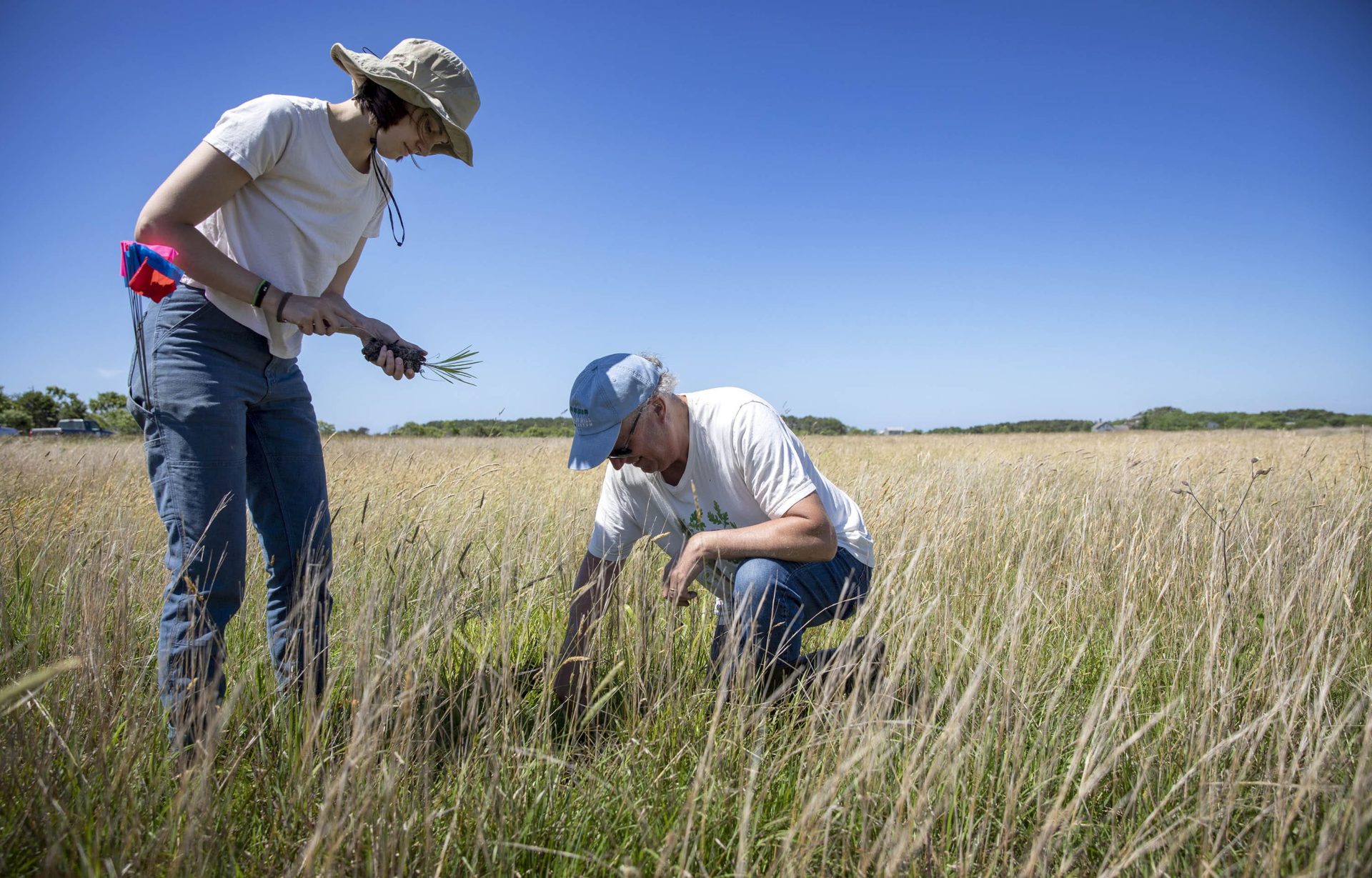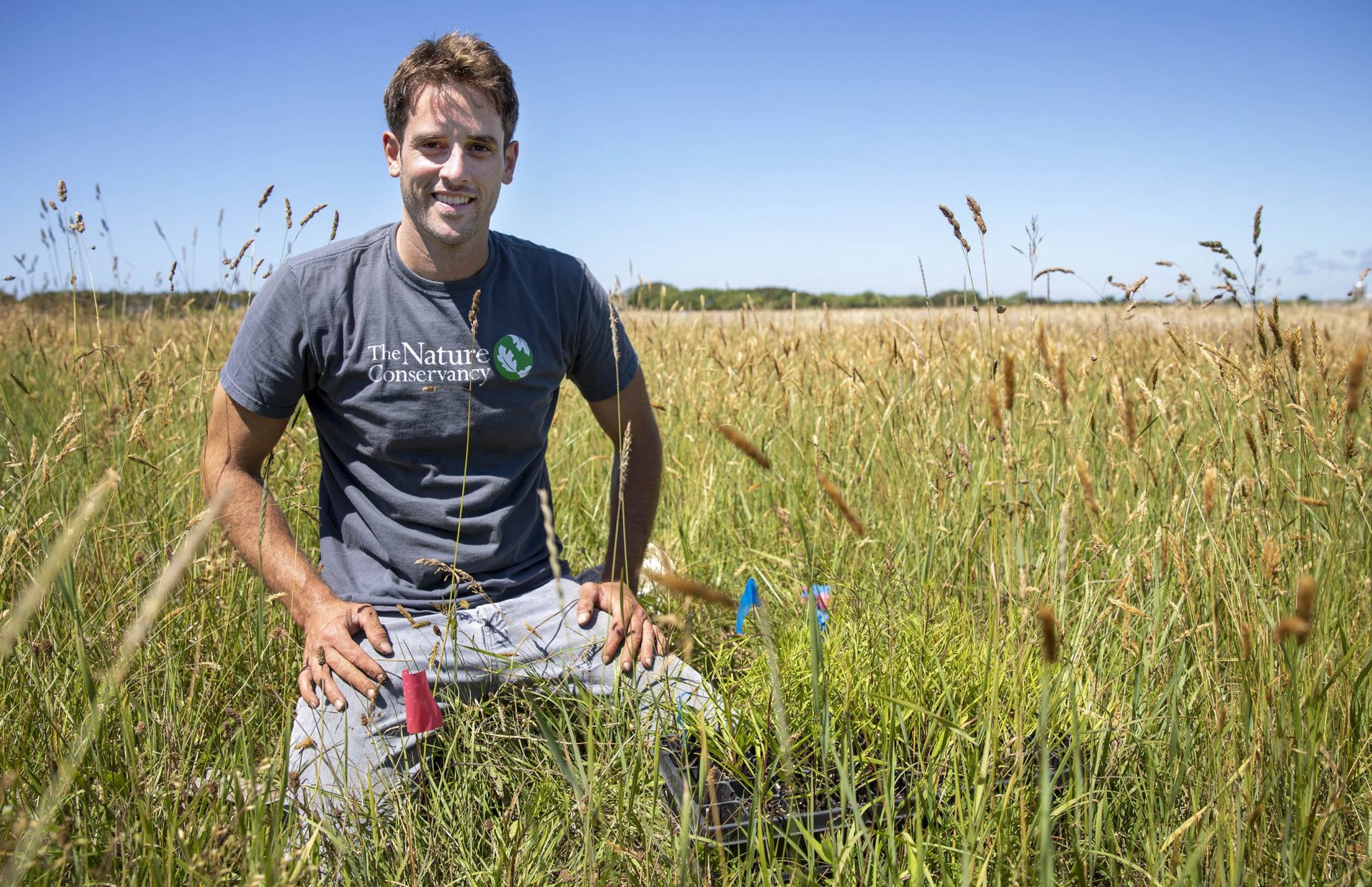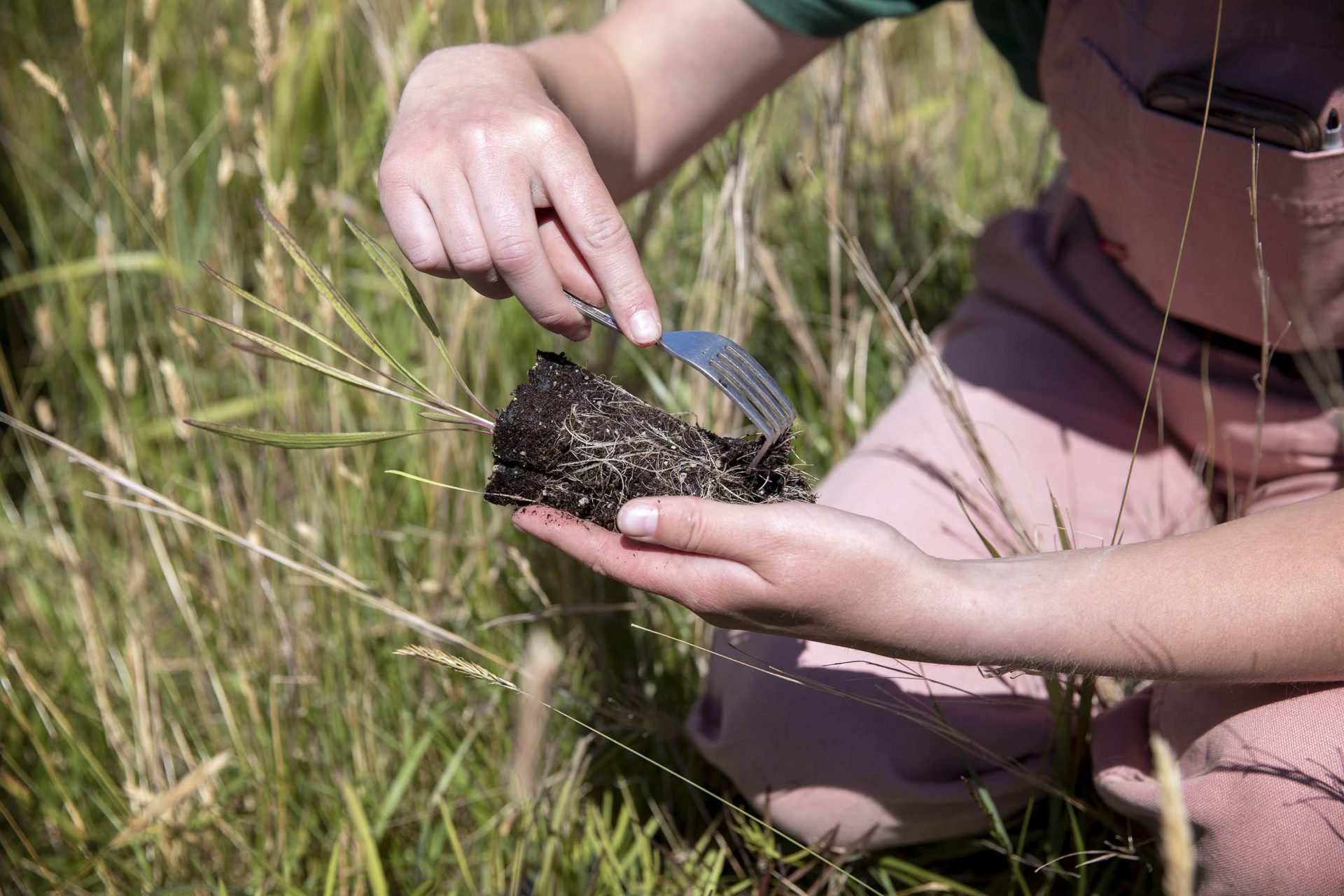Planting 1,000 wildflowers to restore a biodiversity hotspot on Martha’s Vineyard

Blazing star seedling, grown and donated by Polly Hill Arboretum, on their way to be planted on the sandplain grasslands at Katama, on Martha’s Vineyard. (Robin Lubbock/WBUR)
Tim Boland stood next to his black pickup on a dirt road in Edgartown, and waited for a moment. Then, he started handing out wildflowers.
“Who would like a flat?” he called to the dozen-or-so volunteers standing nearby. As they eagerly trotted over to the truck, Boland handed out black plastic trays, each holding fifty seedlings of New England blazing star.
“It’s specialized to New England,” said Boland, executive director of the Polly Hill Arboretum in West Tisbury. He held up a grassy-looking seedling, which did not look like a blazing star — at least not yet. “It’ll form these button-like flowers that are a deep indigo blue, that are just gorgeous. It’s a spectacular plant to see in bloom.”

Linnea Laux holds a blazing star seedling from Polly Hill Arboretum, as Polly Hill Director Tim Boland prepares the ground where they will add the seedling to sandplain grasslands near Edgartown. (Robin Lubbock/WBUR)
The New England blazing star is more than just a pretty blossom: it’s an integral part of a globally-rare ecosystem called a “sandplain grassland.” Just like the name suggests, sandplain grasslands have sandy soil with tall grass, no trees and an exceptionally high number of rare plant and animal species.
That includes plants like the New England blazing star, an important food source for various grassland insects. Today volunteers would plant 1,000 of them to help restore Bamford Preserve, a 60-acre parcel of sandplain grassland on Martha’s Vineyard.
As climate change threatens both human health and the natural world, experts say that protecting biodiversity hotspots like this one will offer the most bang-for-the-buck — protecting threatened species while offering other ecosystem benefits, like open space and flood protection.
But restoration work is expensive: The Nature Conservancy in Massachusetts has been restoring Bamford Preserve from farm field to sandplain grassland for 15 years, at a cost of $15-$20,000 per year. As the climate crisis grows and money tightens, there will be tough choices about what to save, and what to leave behind.
“In conservation, there are limited resources and you want them to have the greatest impact on biodiversity and on the function of ecological systems,” said
Michael Piantedosi, director of conservation with the Native Plant Trust. Piantedosi is not involved with the Bamford Preserve restoration, but says sandplain grasslands are an ecosystem worth saving.
“The reason for investing in that habitat now is so that it has the right makeup and conditions to be able to adapt to climate change going forward,” he said. “All this ecology is connected and you don’t necessarily know what piece will tip the balance in what direction.”

Linnea Laux holds a blazing star seedling ready to plant in the sandplain grasslands near Edgartown, on Martha’s Vineyard. (Robin Lubbock/WBUR)
Sandplain grasslands are found only along the Atlantic Coast from New York to Maine, and most patches are in Massachusetts. Seven rare species of birds use this habitat, including grasshopper sparrows and short-eared owls, as well as beetles, butterflies and wildflowers, like the New England blazing star, found almost nowhere else.
“These little systems right here hold a high concentration of rare and uncommon species in the region,” said Mike Whittemore, stewardship manager for The Nature Conservancy in Massachusetts. “It’s not only the plants, but it’s the wildlife, the pollinators, the things that you don’t always see.”

Mike Whittemore, stewardship manager for The Nature Conservancy on Martha’s Vineyard, kneels in a field near Edgartown where volunteers have been restoring sandplain grasslands. (Robin Lubbock/WBUR)
At this stage of restoration Bamford Preserve doesn’t look like much of a biodiversity hotspot – just a huge field of tall grass and occasional wildflowers, waving in the wind. But even getting to this point has required years of painstaking work.
For example, Tim Boland had to get a special permit to grow New England blazing star because it’s a “species of special concern” in Massachusetts. He collected seed from native wildflowers on the island and carefully cultivated them for two years.
And even after the intensive restoration wraps up in a couple years, Mike Whittemore says the grassland will require maintenance — like controlled burns and occasional mowing — indefinitely.
“There was such a harsh land use history for so many years — it was planting of non-native plants and it was haying and it was plowing,” he said. “When you come through here and plow, it does something in the soil. You need to stay on it to keep it open.”
One of the volunteers, Janet Woodcock from Vineyard Haven, said it’s worth the hard work to preserve or restore the island’s remaining wild spaces, especially in the face of climate change.

Volunteer Niamh Keane loosens the roots of a blazing star seedling, as she prepares to plant it in the sandplain grasslands at Katama, on Martha’s Vineyard. (Robin Lubbock/WBUR)

Volunteers Fanny Riand, Jarod Portillo and Niamh Keane plant seedlings from a tray of blazing star plants on the sandplain grasslands at Katama, on Martha’s Vineyard. (Robin Lubbock/WBUR)
“I mean, the climate has been changing since the Earth started, whenever that was. But it’s happening so quickly that living things don’t have time to adjust to the changes. And so we’re losing species because of that,” Woodcock said. “Anything has a hard time adapting if it happens too quickly.”
Mike Boland, from Polly Hill Arboretum, says stocking the grassland with native plants like the New England blazing star will give all plants and animals living here the best chance of surviving.
“These plants — more than most — have a 14,000 year evolutionary advantage of growing in these ecosystems,” he said. “So there will be plants that persist even with these rough conditions coming on.”
Boland says preserving diverse ecosystems like this is one of our best defenses in the face of a changing climate. For him, he says, it’s an act of hope.
This story was originally published by WBUR, a partner of the New England News Collaborative.
